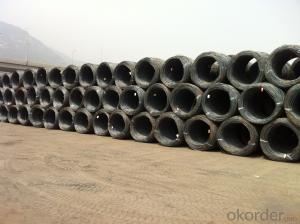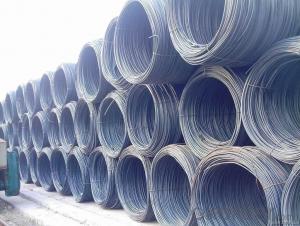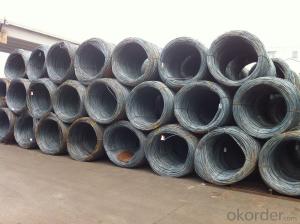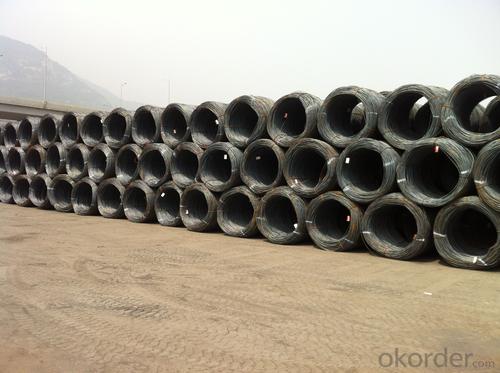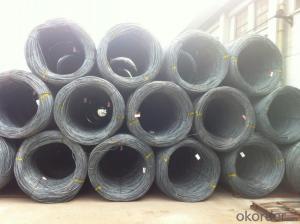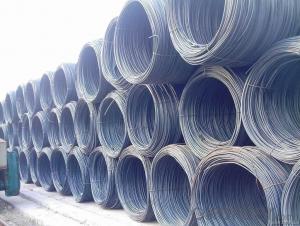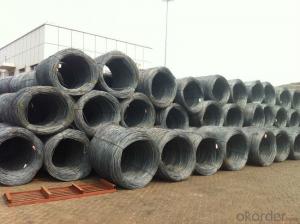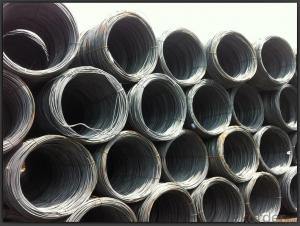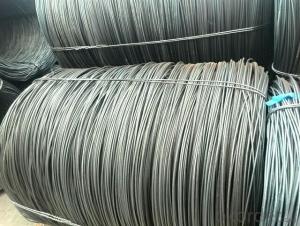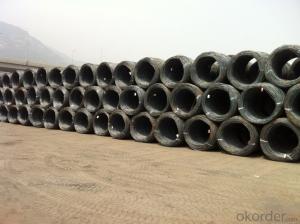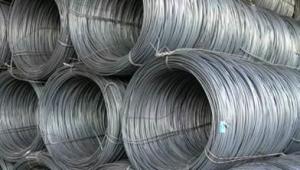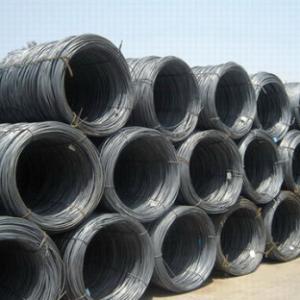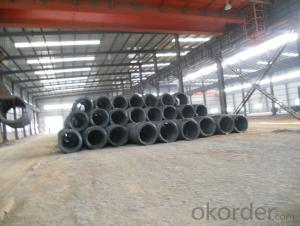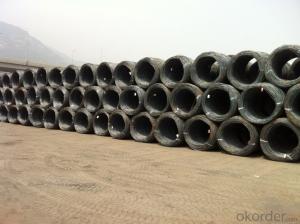Hot Rolled SAE1008 Wire Rods with High Quality
- Loading Port:
- Tianjin
- Payment Terms:
- TT OR LC
- Min Order Qty:
- 25 m.t
- Supply Capability:
- 10000 m.t/month
OKorder Service Pledge
OKorder Financial Service
You Might Also Like
Specification
OKorder is offering SAE1008 Wire Rods at great prices with worldwide shipping. Our supplier is a world-class manufacturer of steel, with our products utilized the world over. OKorder annually supplies products to European, North American and Asian markets. We provide quotations within 24 hours of receiving an inquiry and guarantee competitive prices.
Product Applications:
After hot-rolled the products shaped into coil and delivery as finished product, including round, square, rectangular, hexagonal and so on. Since most of the products are round, it is generally called wire rod. Carbon steel wire rod is widely used in construction and manufacturing. Carbon steel wire rod is mainly used for reinforcement of reinforced concrete and welded structure or reprocessed (roberts , nail, etc.) materials, especially used to produce wire drawing, welding electrode, nails, spring, electronic, precise machinery parts and so on.
Product Advantages:
OKorder's Wire Rods are durable, strong, and resist corrosion.
Main Product Features:
· Premium quality
· Prompt delivery & seaworthy packing (30 days after receiving deposit)
· Corrosion resistance
· Can be recycled and reused
· Mill test certification
· Professional Service
· Competitive pricing
Product Specifications:
Manufacture: Hot rolled
Grade: SAE1006 – SAE1008
Certificates: ISO, SGS, BV, CIQ
Length: 6m – 12m, as per customer request
Packaging: Export packing, nude packing, bundled
Grade | Chemical Composition (%) | |||||
C | Mn | S | P | Si | B | |
SAE1006B | 0.03~O.07 | 0.32max | 0.045max | 0.040max | 0.30max | 0.0008min |
Mechanical properties | ||||||
Yield strength(N/mm2) | Tensile strength(N/mm2) | Elongation (%) | ||||
250-280 | 350-380 | ≥32 | ||||
Grade | Chemical Composition (%) | |||||
C | Mn | S | P | Si | B | |
SAE1008B | 0.10max | 0.3~0.50 | 0.050max | 0.040 max | 0.15max | 0.0008 min |
Mechanical properties | ||||||
Yield strength(N/mm2) | Tensile strength(N/mm2) | Elongation (%) | ||||
≥195 | 315-430 | ≥30 | ||||
FAQ:
Q1: Why buy Materials & Equipment from OKorder.com?
A1: All products offered by OKorder.com are carefully selected from China's most reliable manufacturing enterprises. Through its ISO certifications, OKorder.com adheres to the highest standards and a commitment to supply chain safety and customer satisfaction.
Q2:What's your payment terms ?
A2: We can accept T/T,LC at sight and time LC.
Q3: Can you offer the third part inspection certificates ?
A3: Yes, we can apply third part inspection before shipping, such as SGS, BV, etc .
Images:
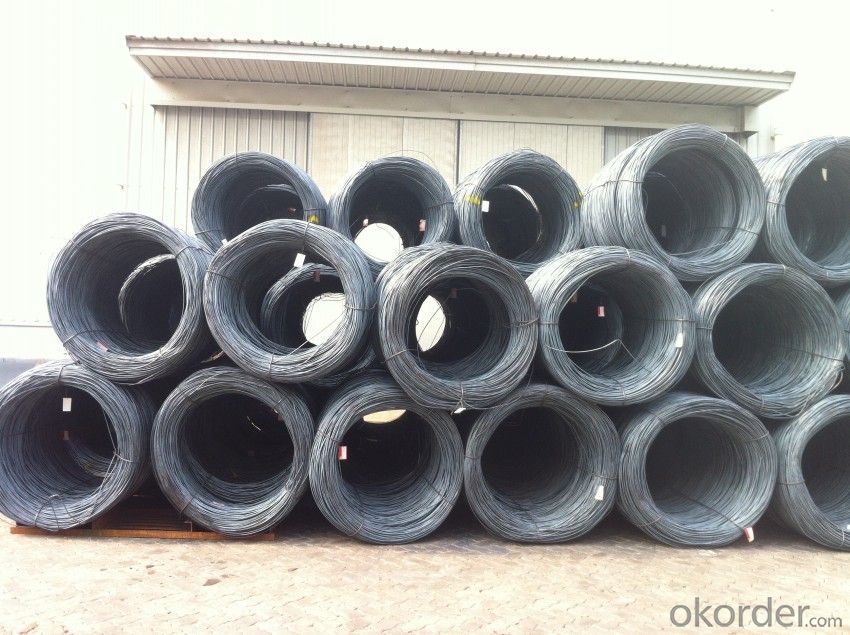
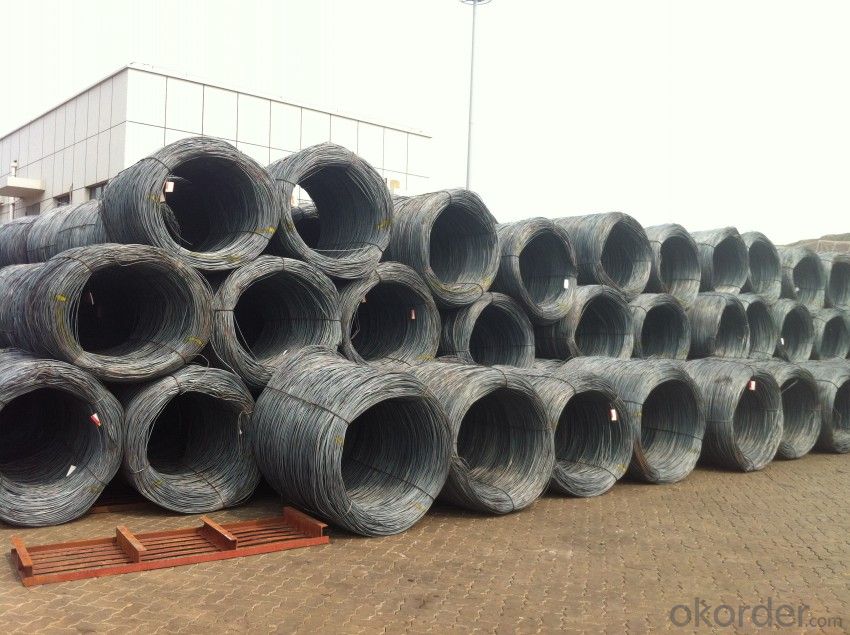
- Q: What are the different types of wire rods for reinforcement made from steel wire rod?
- Wire rods for reinforcement, which are made from steel, come in several different types. These include: 1. Mild Steel Wire Rods: The most commonly used type, these wire rods are made from low carbon steel. They offer good strength and durability, making them suitable for various applications. 2. High Tensile Steel Wire Rods: Specifically designed to provide greater strength and resistance to tension, these wire rods are made from high carbon steel. They are commonly used in construction projects or the manufacturing of heavy machinery. 3. Stainless Steel Wire Rods: Made from corrosion-resistant stainless steel, these wire rods are commonly used in environments prone to corrosion, like coastal areas or chemical processing plants. 4. Galvanized Steel Wire Rods: To protect against corrosion, these wire rods are coated with a layer of zinc. They are often used in outdoor applications or areas with high moisture levels. 5. Copper-Clad Steel Wire Rods: These wire rods have a steel core with a layer of copper cladding. They combine the strength and durability of steel with the excellent electrical conductivity of copper, making them ideal for electrical wiring or grounding systems. In conclusion, the different types of wire rods for reinforcement made from steel offer a range of properties and characteristics to suit various applications and environments.
- Q: What are the main factors affecting the market research of steel wire rod?
- The main factors affecting the market research of steel wire rod include supply and demand dynamics, price fluctuations, industry regulations, technological advancements, competitor analysis, and consumer preferences. Additionally, factors like raw material availability, production capacity, global economic conditions, and geopolitical events also play a significant role in influencing the market research of steel wire rod.
- Q: What are the different weldability testing methods for steel wire rod?
- There are several different weldability testing methods that can be used for steel wire rod. These methods are designed to assess the quality and suitability of the steel for welding purposes. Some of the commonly used weldability testing methods for steel wire rod include: 1. Tensile Test: This test involves applying a gradually increasing force to a welded specimen of the steel wire rod until it breaks. The tensile strength and elongation of the weld are measured to evaluate the quality of the weld. 2. Bend Test: In this test, a welded specimen of the steel wire rod is bent to a specific angle and inspected for any cracks or fractures. This test is used to assess the ductility and resistance to cracking of the weld. 3. Charpy Impact Test: This test measures the impact strength of the steel wire rod weld by striking a notched specimen with a pendulum. The energy absorbed during fracture is measured to determine the toughness of the weld. 4. Hardness Test: The hardness of the weld is often assessed using the Rockwell or Brinell hardness testing methods. This test measures the resistance of the weld to indentation, which can indicate the strength and brittleness of the weld. 5. Macroscopic Examination: This method involves visually inspecting the welded specimen of the steel wire rod for any defects such as cracks, inclusions, or lack of fusion. A magnifying lens or microscope may be used to examine the weld in detail. 6. Microscopic Examination: This test involves examining the microstructure of the weld using a microscope. The microstructure can reveal information about the grain structure, presence of impurities, and any potential weld defects. 7. Non-Destructive Testing (NDT): NDT methods such as ultrasonic testing, magnetic particle testing, or dye penetrant testing can be used to detect any internal or surface defects in the weld without damaging the specimen. These weldability testing methods help assess the quality and performance of the steel wire rod welds, ensuring that they meet the required standards for their intended applications.
- Q: What are the main factors affecting the market advertising of steel wire rod?
- The main factors affecting the market advertising of steel wire rod include the demand and supply dynamics of the industry, the competitive landscape, technological advancements in manufacturing processes, changes in customer preferences and buying behavior, economic conditions and trends, government regulations and policies, and the overall marketing strategies and budgets of steel wire rod manufacturers and distributors.
- Q: What are the disadvantages of using steel wire rods in construction?
- There are a few disadvantages of using steel wire rods in construction: 1. Corrosion: Steel wire rods are susceptible to corrosion, especially in humid and coastal areas. When exposed to moisture and oxygen, steel can rust over time, leading to structural weakness and deterioration. This can compromise the integrity of the construction project and increase maintenance costs. 2. Weight: Steel wire rods are heavy, which can make transportation and installation more challenging. The added weight can also put additional stress on the foundation and supporting structures, potentially leading to structural issues over time. 3. Limited flexibility: Steel wire rods have limited flexibility compared to other construction materials like concrete or timber. This can make it difficult to accommodate complex architectural designs or unique construction requirements. 4. Cost: Steel wire rods can be expensive, especially if high-quality materials are required. Additionally, the cost of transportation, installation, and maintenance can add up, making it a less cost-effective option for some construction projects. 5. Thermal conductivity: Steel has a high thermal conductivity, meaning it can transfer heat quickly. This can lead to increased energy consumption and higher heating or cooling costs in buildings constructed with steel wire rods. 6. Environmental impact: Steel production is resource-intensive and can have a significant environmental impact. The extraction and manufacturing processes emit greenhouse gases and contribute to pollution. Additionally, the disposal of steel wire rods at the end of their lifespan can also pose challenges from an environmental standpoint. Overall, while steel wire rods have numerous advantages in construction, it is essential to consider these disadvantages and evaluate alternative materials based on the specific project requirements, environmental concerns, and budget constraints.
- Q: What are the standard hardness requirements for steel wire rod?
- The standard hardness requirements for steel wire rod are contingent upon various factors, including the intended use and specific industry standards. However, there exist some general principles that can be adhered to. In most instances, the hardness of steel wire rod is gauged using the Rockwell hardness scale. The particular Rockwell hardness (HRC) requirement may differ based on the grade and type of steel wire rod. For instance, low carbon steel wire rod typically falls within the range of 45 to 55 HRC, whereas high carbon steel wire rod may necessitate a hardness requirement of 55 to 65 HRC. Moreover, industry standards like ASTM (American Society for Testing and Materials) or ISO (International Organization for Standardization) may proffer specific hardness requirements for different grades and applications of steel wire rod. These standards guarantee that the wire rod satisfies the requisite mechanical properties for its intended use, encompassing strength, ductility, and wear resistance. It is important to note that the hardness requirements for steel wire rod can also be influenced by customer specifications or specific manufacturing processes. For example, wire rods employed in the production of springs or cables may necessitate more stringent hardness requirements in comparison to those utilized for general applications. Ultimately, it is advisable to consult the pertinent industry standards, customer specifications, or specific product requirements to ascertain the standard hardness requirements for steel wire rod within a given context.
- Q: How is steel wire rod used in the production of wire mesh?
- Wire mesh production relies heavily on steel wire rod, which serves as a vital component. This versatile material, also known as wire cloth or wire fabric, finds application in numerous industries for various purposes. To initiate the wire mesh production, steel wire rod undergoes hot rolling, a process wherein molten steel is passed through rollers to form a continuous, elongated rod with a specific diameter. The diameter of the steel wire rod may vary based on the desired end product and application of the wire mesh. After the production of steel wire rod, it is drawn through dies to further reduce its diameter. This drawing process not only reduces the diameter but also enhances the wire's tensile strength and surface finish. Consequently, the drawn wire becomes suitable for utilization in wire mesh production. The wire mesh machine is responsible for processing the steel wire rod. It undergoes a series of procedures to form the wire mesh. Initially, the wire is straightened and cut to the required length. These cut wire lengths are then fed into a weaving machine, where they are interwoven to create the desired mesh pattern. The wire mesh machine employs various techniques, including plain weave, twill weave, or Dutch weave, to manufacture different types of wire mesh. The steel wire rod functions as the fundamental building block for these patterns, providing the necessary strength and durability for the wire mesh to withstand diverse applications. Once the wire mesh is woven, it proceeds through additional processes, such as galvanizing or coating, to enhance its properties. Galvanizing involves applying a zinc coating to protect the wire mesh from corrosion, while coating can provide additional attributes such as heat resistance, chemical resistance, or abrasion resistance. In conclusion, steel wire rod plays a vital role in wire mesh production. It serves as the starting material, undergoes processing and weaving to create various wire mesh patterns, and offers the requisite strength and durability for applications across different industries.
- Q: What are the environmental impacts of producing steel wire rod?
- The production of steel wire rod can have various environmental impacts, both during the extraction of raw materials and the manufacturing process. Here are some of the key environmental impacts associated with producing steel wire rod: 1. Resource extraction: Steel wire rod is primarily made from iron ore, which requires extensive mining activities. These mining operations can lead to deforestation, habitat destruction, and soil erosion. Furthermore, the extraction and transportation of iron ore contributes to greenhouse gas emissions and air pollution. 2. Energy consumption: The production of steel wire rod involves several energy-intensive processes, such as smelting, refining, and shaping. These processes typically rely on fossil fuels, such as coal and natural gas, which release large amounts of carbon dioxide into the atmosphere. High energy consumption not only contributes to climate change but also depletes non-renewable resources. 3. Air and water pollution: The manufacturing process for steel wire rod can release various pollutants into the air and water. During smelting, emissions of sulfur dioxide, nitrogen oxides, and particulate matter can contribute to air pollution and acid rain. Water pollution can occur through the discharge of wastewater containing heavy metals, oil, and chemicals used in the production process, potentially contaminating nearby water bodies. 4. Waste generation: Steel wire rod production generates significant amounts of waste materials, including slag, dust, and sludge. These waste products often contain harmful substances, such as heavy metals and toxic chemicals, which can pollute the environment if not properly managed. Waste disposal can also contribute to land degradation and the depletion of natural resources. 5. Carbon emissions: Steel production, including the production of wire rod, is a major contributor to global carbon emissions. The high temperatures required to convert iron ore into steel result in the release of large amounts of carbon dioxide. Additionally, the use of fossil fuels in the manufacturing process further adds to the carbon footprint of steel wire rod production. To mitigate these environmental impacts, the steel industry has been adopting various measures such as implementing cleaner technologies, improving energy efficiency, and reducing reliance on fossil fuels. Additionally, recycling steel scrap can significantly reduce the environmental burden associated with steel wire rod production.
- Q: How is steel wire rod used in the manufacturing of wire forms for display racks?
- The manufacturing of wire forms for display racks heavily relies on steel wire rod. This component plays a vital role as the raw material that is subjected to a range of manufacturing processes in order to create wire forms with precise shapes and sizes. The initial step involves carefully selecting the appropriate quality and diameter of steel wire rod. This selection process is dependent on the desired strength, durability, and flexibility of the wire forms. Once the suitable steel wire rod has been chosen, it is fed into a wire drawing machine. In this machine, the steel wire rod is pulled through a series of dies, effectively reducing its diameter and increasing its length. Once the wire has been successfully drawn to the desired size, it proceeds to undergo a series of shaping and bending processes. These processes may entail the utilization of specialized machines or tools to bend the wire into specific angles, curves, or shapes that are required for the display racks. Additionally, the wire may also be cut into specific lengths as per the design requirements. In order to retain the desired shape and structure of the wire forms, further processes such as heat treatment or galvanization may be carried out. Heat treatment serves to strengthen the wire forms, making them more resistant to bending or deforming when subjected to heavy loads. On the other hand, galvanization entails applying a protective layer of zinc onto the wire forms to safeguard against corrosion, thereby enhancing their lifespan. Once the wire forms have been shaped, bent, and treated, they are now ready to be assembled into the display racks. These wire forms can be employed for various purposes within the display rack industry, such as forming shelves, hooks, or frames. The versatility of steel wire rod allows for the production of wire forms in different designs, sizes, and load capacities, thus enabling them to meet the specific requirements of display rack applications. To summarize, the manufacturing process of wire forms for display racks heavily relies on steel wire rod. This crucial component undergoes a range of processes including wire drawing, shaping, bending, and treatment to produce wire forms with specific shapes, sizes, strength, and durability. Once assembled into display racks, these wire forms provide a robust and adaptable solution for showcasing products.
- Q: What are the main factors affecting the market sales of steel wire rod?
- The main factors affecting the market sales of steel wire rod include demand from various industries such as construction, automotive, and manufacturing, global economic conditions, price fluctuations of raw materials like iron ore and scrap metal, competition from alternative materials, technological advancements in production processes, and government policies and regulations pertaining to the steel industry.
Send your message to us
Hot Rolled SAE1008 Wire Rods with High Quality
- Loading Port:
- Tianjin
- Payment Terms:
- TT OR LC
- Min Order Qty:
- 25 m.t
- Supply Capability:
- 10000 m.t/month
OKorder Service Pledge
OKorder Financial Service
Similar products
Hot products
Hot Searches
Related keywords
